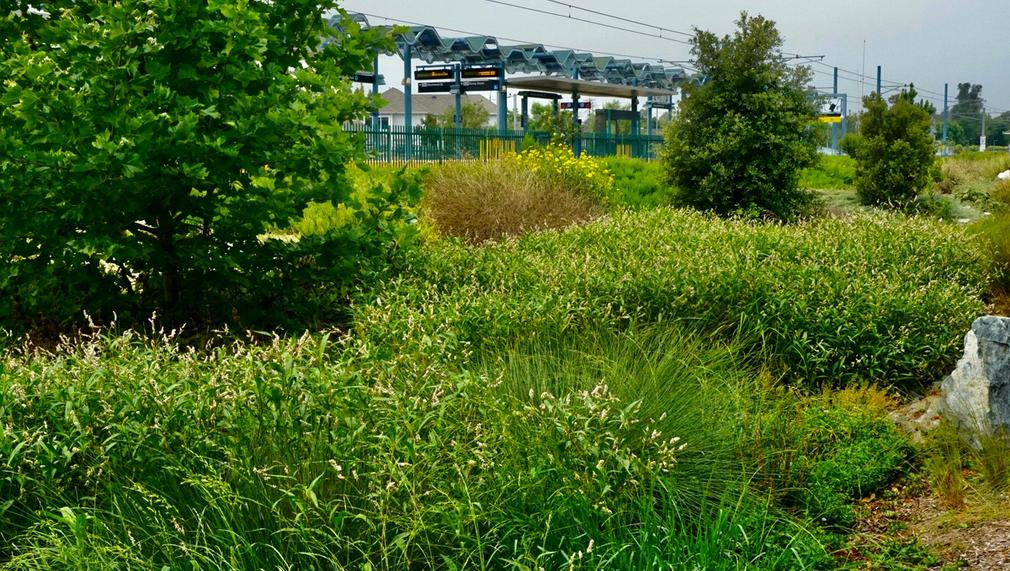More Green with Less Water: Spreading Awareness & Changing Practices
Treating urban runoff began at the Westwood Greenway in October 2020. Native landscaping (both planted and voluntary) and the biodiversity it provides is showcased. Modeling the multiple benefits of the greenway concept, the sustainable power of natives, and the potential for water conservation in the face of climate change is our goal. We will spread our concept to E-Line Metro riders with a vibrant mural and to learners of all ages on-site as a place for tours, school field trips, research, and local workforce job training.

Please list the organizations collaborating on this proposal.
Renee Fox, artist
What is the primary issue area that your application will impact?
Climate and Environment
In which areas of Los Angeles will you be directly working?
West LA
County of Los Angeles
City of Los Angeles
In what stage of innovation is this project, program, or initiative?
Pilot or new project, program, or initiative
What is your understanding of the issue that you are seeking to address?
To LIVE in Los Angeles we need to be water efficient and climate resilient well before 2050. Water shortages, heat islands, and weather extremes will get worse. For our health we need to increase our green spaces and use them for exercise, cooling, and community. But they are suffering, and past practices need to be changed: -Our non-native street trees use six times more water than native species. -70% of residential water use in Los Angeles irrigates (primarily non-native) landscaping. The fertilizers used for non-native plants are a big source of runoff pollution in LA's urban watersheds and Santa Monica Bay. -The LA region consumed 25% more water in April 2022 than April 2020. -Leaf blowers and lawn mowers cause air and noise pollution. -LA has lost over 90% of local butterflies and songbirds since ~1900 due to replacing native habitat with non-natives. There is little awareness of the impact our "usual" practices have on our water supply and our health, or that we can change.
Describe the project, program, or initiative this grant will support to address the issue.
The Westwood Greenway's vegetated creek treats urban runoff. The upland is landscaped with natives (adapted to dry hot summers and short winters), that add beauty and biodiversity to the city. The Greenway shows that we can reduce water usage and water pollution while increasing biodiversity, tree cover, and green spaces which cool LA. To multiply the effect, we want to: 1. Change what is seen as a beautiful yard: it is a sustainable palette of natives supporting wildlife, and a ground cover of leaf litter and mulch that feeds the soil. 2. Model changed maintenance practices and eliminate fertilizers and poisons. 3. Show our neighbors, elected's, and professional landscapers what this new landscape can look like and how to create it. Expose children to nature and science. The Greenway is a living lab. Located next to a Metro station, it is accessible from across the County. Part 1 of our initiative is a 350-400 sq.ft. mural visible from the station platform. The artist would collaborate with experts to design the mural with life-size wildlife and plants, highlighted with clusters of text on key points. School field trips, tour groups, neighbors, and workforce trainees would see it as well. Part 2 is to hire a part-time coordinator to plan community events, conduct outreach, and collaborate with maintenance professionals. The Theodore Payne Foundation, TreePeople, Natural History Museum, Surfrider, UCLA, and others will be invited to continue their involvement.
Describe how Los Angeles County will be different if your work is successful.
As native plants replace non-native landscaping in residential yards and on public parcels, LA County would transition from urban hardscape to cities with vibrant patchworks of sustainable green spaces, which could survive our hotter and drier future. METRO would expand their use of native landscaping and model best maintenance practices. Anyone near a station could see what is possible and learn from what we have done. Water usage would be reduced while native birds, insects, and other animals would flourish and fewer pollutants would enter our ecosystem. Greenways would provide health and community benefits, and students of all ages could enjoy and learn from nature near them. Landscapers would practice maintenance and irrigation methods appropriate to the plants, and a beautiful yard would be a sustainable one filled with biodiversity. Working together to live within our environment will allow us adequate water, cleaner air and water, and access to the benefits of nature.
What evidence do you have that this project, program, or initiative is or will be successful, and how will you define and measure success?
Success of Part 1, the mural, will be primarily measured by its creation and secondarily by an estimate of number of viewers and records of comments received. Collaborative time spent on research and design will be documented and the mural will be registered with the City. Success of Part 2, the Coordinator, will be an evaluation of the planning and execution (including number and size) of community events, work parties, school visits, and workforce seminars. Records of outreach (numbers and populations reached), presentations, hands-on activities, and research reports will be maintained. One measure of overall success would be to obtain a commitment from the METRO Board to use sustainable maintenance practices, and direction to their contractors to ensure that. A second would be an increase in the number of local residents removing turf and installing native plants and mulch. A third would be outreach efforts leading to new Greenways being proposed in other parts of the City.
Approximately how many people will be impacted by this project, program, or initiative?
Direct Impact: 950
Indirect Impact: 12,000